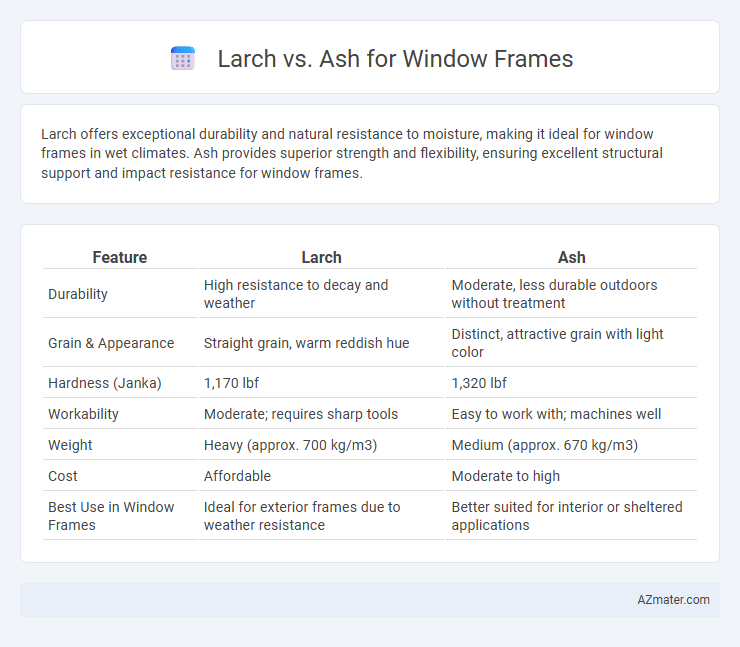Larch offers exceptional durability and natural resistance to moisture, making it ideal for window frames in wet climates. Ash provides superior strength and flexibility, ensuring excellent structural support and impact resistance for window frames.
Table of Comparison
| Feature | Larch | Ash |
|---|---|---|
| Durability | High resistance to decay and weather | Moderate, less durable outdoors without treatment |
| Grain & Appearance | Straight grain, warm reddish hue | Distinct, attractive grain with light color |
| Hardness (Janka) | 1,170 lbf | 1,320 lbf |
| Workability | Moderate; requires sharp tools | Easy to work with; machines well |
| Weight | Heavy (approx. 700 kg/m3) | Medium (approx. 670 kg/m3) |
| Cost | Affordable | Moderate to high |
| Best Use in Window Frames | Ideal for exterior frames due to weather resistance | Better suited for interior or sheltered applications |
Introduction to Larch and Ash for Window Frames
Larch wood, prized for its natural durability and high resin content, offers exceptional resistance to moisture and decay, making it a preferred choice for sustainable window frames in harsh climates. Ash wood, known for its strength, flexibility, and light color, provides excellent stability and impact resistance, enhancing both the structural integrity and aesthetic appeal of window frames. Both larch and ash are valued in window frame manufacturing for their unique combination of durability and workability, catering to different architectural and environmental requirements.
Wood Characteristics: Larch vs Ash
Larch wood offers exceptional durability and natural resin content, making it highly resistant to moisture and decay, ideal for window frames exposed to harsh weather. Ash wood boasts a strong, flexible grain structure with a light color and smooth finish, providing excellent shock resistance and ease of machining. While Larch provides superior weather resistance, Ash delivers better workability and aesthetic appeal for interior window frame designs.
Durability and Weather Resistance
Larch wood offers superior durability and natural resin content, making it highly resistant to rot and insect damage, which is ideal for window frames exposed to harsh weather. Ash wood, while strong and tough, is less resistant to prolonged moisture and may require additional treatments to withstand weather conditions effectively. Choosing larch enhances long-term weather resistance and reduces maintenance compared to ash in exterior applications.
Aesthetic Appeal and Grain Patterns
Larch wood offers a warm reddish-brown hue with pronounced, straight grain patterns that create a rustic yet refined aesthetic, ideal for traditional and contemporary window frames. Ash wood features a lighter, creamy color and a more uniform, wavy grain that delivers a sleek and modern look, enhancing minimalist or Scandinavian designs. Choosing between Larch and Ash depends on desired visual impact--Larch emphasizes natural texture and depth, while Ash provides a smooth, subtle grain that brightens interior spaces.
Insulation Properties
Larch wood offers superior thermal insulation for window frames due to its dense grain structure, effectively reducing heat transfer and improving energy efficiency in buildings. Ash wood, while strong and durable, has a more open grain pattern that results in slightly lower insulation performance compared to larch. Choosing larch over ash for window frames enhances indoor temperature regulation, contributing to lower heating and cooling costs.
Maintenance Requirements
Larch window frames require less frequent painting and can tolerate occasional neglect due to their natural resin content that repels moisture and pests. Ash, while strong and aesthetically pleasing, demands regular sealing or painting to prevent warping and decay from prolonged exposure to moisture. Choosing larch minimizes annual maintenance efforts, making it suitable for homeowners seeking durability with lower upkeep.
Sustainability and Environmental Impact
Larch wood is highly valued for window frames due to its natural durability and slow growth, resulting in a dense grain that enhances longevity and reduces replacement frequency, contributing to sustainable use of resources. Ash, while offering excellent strength and flexibility, grows faster but often requires more chemical treatment to withstand weathering, which can increase its environmental footprint. Choosing larch minimizes environmental impact through its carbon sequestration during slow growth and reduced need for chemical preservatives, making it a superior sustainable option for eco-conscious window frame construction.
Cost Comparison
Larch window frames typically cost more than ash due to their natural durability and resistance to rot, making them a long-term investment despite a higher initial price. Ash, being more affordable, offers a budget-friendly option with good strength and aesthetic appeal but may require more maintenance over time. Comparing lifecycle costs, larch frames often prove more economical in harsh climates, while ash suits moderate environments with lower upfront expenses.
Suitability for Different Architectural Styles
Larch wood, with its natural reddish hue and pronounced grain, complements rustic, traditional, and Scandinavian architectural styles by offering warmth and durability. Ash wood's lighter, uniform texture suits modern, minimalist, and contemporary designs, providing a sleek and clean appearance ideal for frames emphasizing simplicity. Both woods provide strong structural integrity, but choice depends on aesthetic alignment with the architectural style, where Larch enhances earthy tones and Ash supports bright, airy interiors.
Conclusion: Choosing the Right Wood for Window Frames
Larch offers exceptional durability and natural resistance to moisture, making it ideal for window frames exposed to harsh weather conditions, while ash provides superior strength and a smooth, attractive grain suited for interior windows or decorative purposes. Selecting between larch and ash depends on the specific environmental exposure and aesthetic preferences desired; larch excels in longevity and outdoor resilience, whereas ash stands out for its workability and refined appearance. Prioritizing factors such as durability, maintenance, and design will ensure the right wood choice enhances window frame performance and longevity.

Infographic: Larch vs Ash for Window Frame
 azmater.com
azmater.com